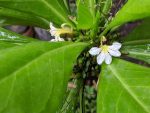 Also known as beach cabbage and sea lettuce, beach naupaka is a dense, spreading evergreen shrub growing 3-10’ tall and native to beaches and tropical coastal habitats such as salt marshes, mangroves, and sand dunes of the Indo-Pacific including Hawaii.. It is a member of the Goodeniaceae family that is found mostly in Australia. The medium green leaves are elliptical, waxy, fleshy, smooth and 1.5 to 8 inches long. The fragrant, white to cream colored flowers appear in clusters of three all year around and may be blushed with pink, purple, or violet. They have five petals all positioned on one side of the flower as though half of the petals had been torn off. The fruits are fleshy white to greenish white berries with corky exterior that allows them to float for up to a year and facilitates their dispersion by ocean currents. Plants are used to prevent coastal erosion , protect cultivated plants from the salt spray, to enhance the beach landscape , and in Hawaii the flowers are used to make leis. The genus name, Scaevola, comes from the Greek word scaevus meaning left handed or awkward and probably refers to the form of the flowers.
Also known as beach cabbage and sea lettuce, beach naupaka is a dense, spreading evergreen shrub growing 3-10’ tall and native to beaches and tropical coastal habitats such as salt marshes, mangroves, and sand dunes of the Indo-Pacific including Hawaii.. It is a member of the Goodeniaceae family that is found mostly in Australia. The medium green leaves are elliptical, waxy, fleshy, smooth and 1.5 to 8 inches long. The fragrant, white to cream colored flowers appear in clusters of three all year around and may be blushed with pink, purple, or violet. They have five petals all positioned on one side of the flower as though half of the petals had been torn off. The fruits are fleshy white to greenish white berries with corky exterior that allows them to float for up to a year and facilitates their dispersion by ocean currents. Plants are used to prevent coastal erosion , protect cultivated plants from the salt spray, to enhance the beach landscape , and in Hawaii the flowers are used to make leis. The genus name, Scaevola, comes from the Greek word scaevus meaning left handed or awkward and probably refers to the form of the flowers.
Type: Flowering evergreen shrub
Outstanding Feature: Flowers, foliage
Form: Mound
Growth Rate: Rapid
Bloom: Clusters of three fragrant, white to cream colored flowers sometimes blushed with pink, purple or violet with 5 petals on one side of the flower; year around bloom
Size: 3-10’ H x 4-8’ W
Light: Full sun
Soil: Sandy, dry, well-drained
Hardiness: Zones 10-11
Care: Low maintenance
Pests and Diseases: Leaf spot
Propagation: Seeds, cuttings, layering
Photo Credit: Vengolis, Wikimedia